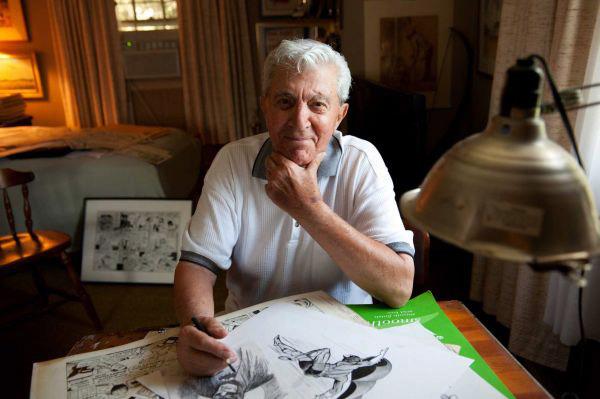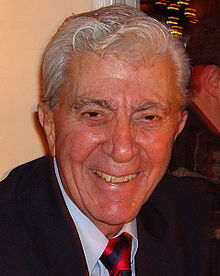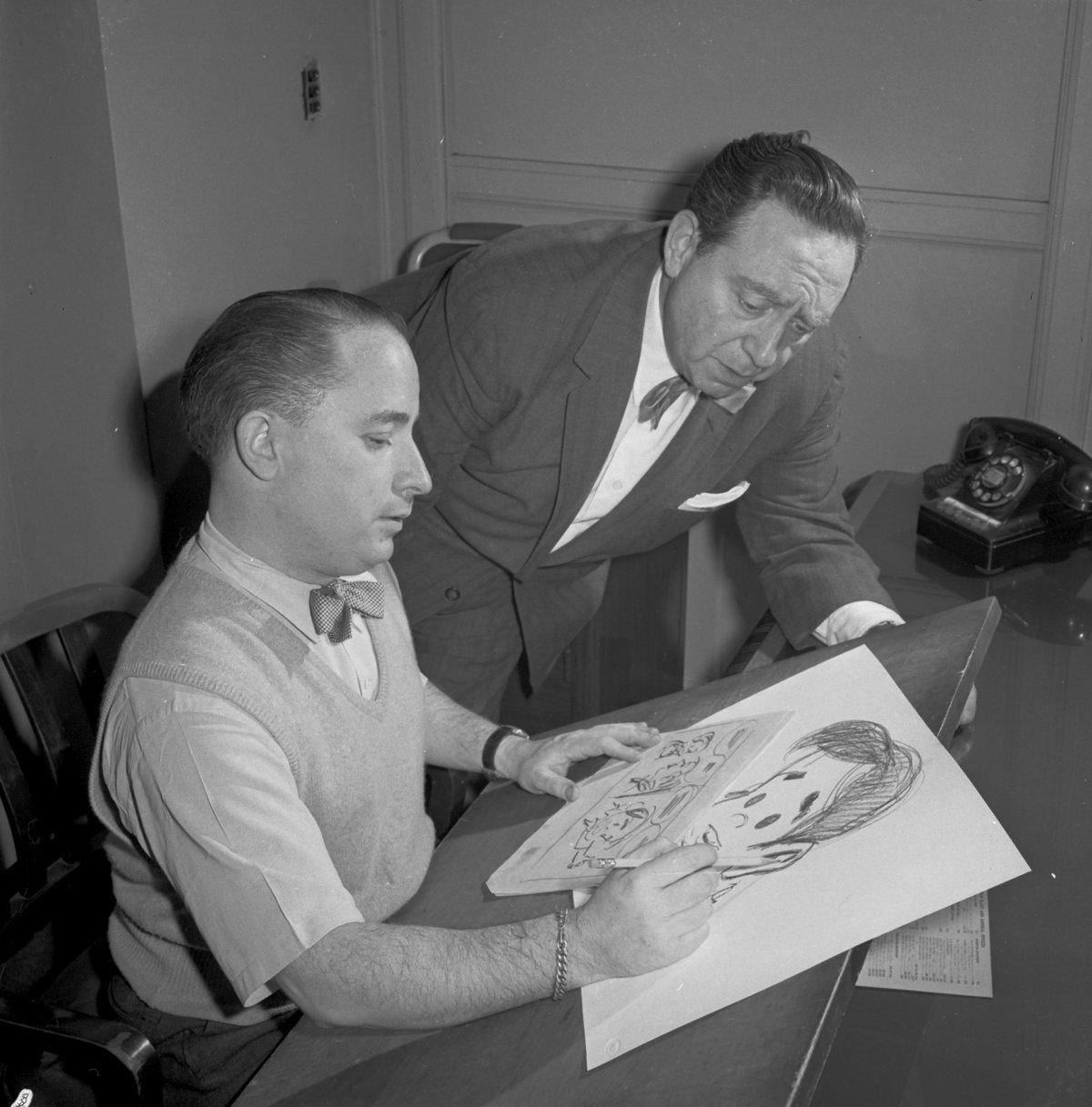An Interview With Creig Flessel - Early Sandman Artist and Creator of The Shining Knight
/Written by Bryan Stroud
Creig Flessel sitting at his drawing table.
Creig Valentine Flessel (born February 2, 1912) was an American comic book artist, illustrator, and cartoonist for magazines ranging from Boys' Life to Playboy. One of the earliest comic book illustrators, he broke into comics after answering an ad in the New York Times by Major Malcolm Wheeler-Nicholson (whose National Allied Publications would eventually become DC Comics) and began freelancing there. During his time at DC, Creig would help to shape the aesthetic of the fledgling publisher by providing early cover art for More Fun Comics, Adventure Comics (before Superman), and Detective Comics (before Batman). He drew the very first cover appearance of Sandman (on Adventure Comics #40) and created the Shining Knight (Adventure Comics #66). Starting in 1960, Mr. Flessel began drawing comic strips for newspapers and magazines, though he still did an occasional job for DC Comics as well. In 2006 he was nominated for induction into the Will Eisner Hall of Fame. He passed away on July 17, 2008 after suffering complications from a stroke.
Creig Flessel was another living legend when I took the opportunity to speak with him. For heaven's sake, he was doing work on covers before the debut of Superman or Batman on the Detective Comics line. We had a too brief but interesting chat about some of the things that he'd done over an incredibly long career and I'm fortunate that he spared a little time for me.
This interview originally took place over the phone on January 19, 2008.
The pulps: an illustration from the October 1939 issue of Detective Yarns. Art by Creig Flessel.
The pulps: an illustration from the December 1941 issue of Super Sports. Art by Creig Flessel.
The pulps: an illustration from the July 1940 issue of The Shadow. Art by Creig Flessel.
Bryan Stroud: Please tell me about your involvement with the National Cartoonist’s Society.
Creig Flessel: I started the Berndt Toast Gang with Walter Berndt.
Stroud: Yeah, in fact Frank Springer told me he thought you were the one that named it.
CF: Yes. I named it. I did, along with Lee Ames. He and Frank…Frank did the design and I will take credit for naming it. It was a natural.
Stroud: Okay, and you’ve been actively involved for all those years, right?
CF: Oh, yeah. We started way back during the war. We used to go to the hospitals, Veteran’s hospitals, and do a stand-up show or do drawings of the wounded G.I.’s, and that was how the Berndt Toast really started. That was our social work.
Stroud: That’s wonderful. I know when I’ve talked with some of the other creators, like Al Plastino, they got involved in some of those trips and events both locally and overseas like what you’ve just described.
CF: Al?
Stroud: Al Plastino, who did Superman for many years.
CF: Oh, yeah. You’re going way back.
Stroud: Yes. And of course, Irwin Hasen and Lew Sayre Schwartz.
CF: Yeah. Well, the Berndt Toast basically went around Long Island, New York, Queens, New Jersey, and New York State hospitals.
Creig Flessel.
Stroud: Oh, fantastic. That must have been satisfying work to do.
CF: Yeah. We had a good time.
Stroud: Good for you. Now back when you started, Mr. Flessel, what sort of training did you have in art?
CF: Well, I got a couple of years of art school. Grand Central. I studied with Harvey Dunn, Charles DeFao. That was during the Depression times. 1930.
Stroud: You actually started your career before anybody heard of Superman or Batman.
CF: I started in the comics in ’35. So, if you can top that, well, that’s it.
Stroud: Can’t beat it. It can’t be done.
CF: No, that’s true.
Stroud: They assembled the comic books very differently back then, didn’t they?
CF: Well, yeah, you did the whole thing. There was no production line. It was the Henry Fords of the business and we didn’t think it was going anywhere. It was just a chance to make a few bucks.
Stroud: Did you have to do your own lettering at that time?
CF: My own lettering, penciling, inking, color guides, the whole schmear.
Stroud: Holy cow. That must have been quite an interesting jump into the deep end of the pool.
CF: Well, it was five dollars a page. That was a lot of money.
Stroud: (Chuckle.) So, you were able to keep body and soul together.
CF: Yeah.
A Sandman commission by Creig Flesel, done in 2006.
Stroud: I read where you did a lot of work on Sandman and that you actually created The Shining Knight. Is that true?
CF: That’s true. Yeah, that’s way back.
Stroud: What sort of characters did you like working on the best do you think?
CF: Well, I really didn’t think too much about it. I like semi-comic, but any chance to draw a picture, you know at that time, was welcome. And the fact that I could do most everything made me invaluable. In fact, just the other day I met Major Nicholson’s grandson. He was out here in California. The Major, you know, he was the one who started the whole business.
Stroud: He sure did. Did you know him very well?
CF: Well, (chuckle) as well as you can know a man who was being chased by process servers and who didn’t have any money. You know, he was running all the time.
Stroud: He tried to stay low profile, huh?
CF: Yeah.
The first appearance of the Shining Knight, by Creig Flessel - from Adventure Comics #66.
Stroud: I can well imagine. Do you know Ramona Fradon?
CF: She’s a Silver Age artist. I know her work, but I don’t know her personally. I was just there in the beginning and that’s when I got out. I got into advertising and had a checkered career. I did this and I did that. But I had a good time and here I am.
Stroud: And you did very well. The thing I was going to mention about Ramona, just in case you didn’t know it, when I talked to her she said the first comic book assignment she ever had was doing a Shining Knight story.
CF: Is that right?
Stroud: Yeah. I didn’t know if you knew that or not.
CF: No, I never knew that.
Stroud: I see where you did a little writing for a while. Did you like doing that or did you prefer doing the art?
CF: Well, the writing was non-essential. It was just something to hold the story, the thing together. They were pretty bad. I didn’t take much time with my writing. I didn’t think about it. I just wanted a chance to draw a picture.
Stroud: Did you have a favorite writer that you worked from?
CF: Well, you can go back to Joseph Conrad and all the others on Adventure Comics. I came out of the pulps, you know. So I probably had the best of writers and the worst of writers as I went along. But I really didn’t know what I was doing in the beginning. It was just a place to sit down and draw.
Stroud: Everybody was learning at that point, so you’re a pioneer of the whole genre.
CF: That’s right. I try to tell them I was a pioneer, but they bring up other guys and a lot of other guys get the credit.
Stroud: That doesn’t make any sense to me. Do you remember which editors you worked with?
CF: Sullivan and Whitney Ellsworth were the only two I worked with, really.
Stroud: Did you work pretty well with them?
CF: Oh, yeah. They were no problem. I wasn’t a problem. That was before we had problems. Everybody loved everybody and you’d do your job and shut up and go home. You’d take your five dollars and blow it. Buy a hamburger or whatever.
Stroud: Yep. Just pull together and get it done. Which other artist’s work did you like at the time?
CF: I didn’t really have any of the other old-timer’s work to judge by. I was there in the beginning, and what I did was my own. So really, except for the old masters like Howard Pyle. The illustrators, there was nothing to base it on, so I was on the cutting edge. Matt Clark was there, of course, but who did I have to look at?
Sheldon Moldoff & Creig Flessel.
Stroud: That’s true. You were out there creating it on your own.
CF: Well, yeah. As much as I could.
Stroud: You did a whole lot of covers on the old comic books. Did you like doing those better than the interiors or did it make any difference to you?
CF: Well, there again, you know, I was there, they said to me, “We need the cover,” and I did the cover. It wasn’t a case of likes or dislikes. Just sit down and do it and shut up.
Stroud: (Laughter.) Did they pay more for a cover at that time?
CF: They paid ten dollars.
Stroud: Okay, so I guess in some ways it was a little better.
CF: Yeah, ten dollars is better than five.
Stroud: (Laughter.) Did you know Fred Guardineer?
CF: Yeah, very well. Freddie was a great draftsman, but there again he realized he couldn’t make a good living at it, so he became a mailman. He ended up with the post office department.
Stroud: I’ll be darned. I guess it offered a better benefit package anyway.
CF: (Chuckle.) Yeah. He retired out here in San Ramon. Well, it was nice talking to you.
Stroud: Well Mr. Flessel, I certainly appreciate your time and I wanted to wish you an early happy birthday and to congratulate you on the exhibit they’re doing on your work and career.
CF: Thank you. I hope to see it.
Stroud: I’m sure you will.
The pulps: an illustration from the Fall 1942 issue of Sports Fiction. Art by Creig Flessel.
The pulps: an illustration from the Fall 1942 issue of Sports Fiction. Art by Creig Flessel.
The pulps: an illustration from the Fall 1942 issue of Sports Fiction. Art by Creig Flessel.
As with the Joe Simon interview from last week, we felt that the conversation with Creig was a little short - and so we are including a gallery of some of the many cover illustrations & newspaper strips that Mr. Flessel helped to create.
New Adventure Comics (1937) #15, cover by Creig Flessel.
New Adventure Comics (1937) #16, cover by Creig Flessel.
New Adventure Comics (1937) #17, cover by Creig Flessel.
New Adventure Comics (1937) #18, cover by Creig Flessel.
New Adventure Comics (1937) #19, cover by Creig Flessel.
New Adventure Comics (1937) #20, cover by Creig Flessel.
New Adventure Comics (1937) #21, cover by Creig Flessel.
New Adventure Comics (1937) #22, cover by Creig Flessel.
New Adventure Comics (1937) #23, cover by Creig Flessel.
New Adventure Comics (1937) #24, cover by Creig Flessel.
New Adventure Comics (1937) #25, cover by Creig Flessel.
New Adventure Comics (1937) #26, cover by Creig Flessel.
New Adventure Comics (1937) #27, cover by Creig Flessel.
New Adventure Comics (1937) #28, cover by Creig Flessel.
New Adventure Comics (1937) #29, cover by Creig Flessel.
New Adventure Comics (1937) #30, cover by Creig Flessel.
New Adventure Comics (1937) #31, cover by Creig Flessel.
Adventure Comics (1938) #32, cover by Creig Flessel.
Adventure Comics (1938) #33, cover by Creig Flessel.
Adventure Comics (1938) #37, cover by Creig Flessel.
Adventure Comics (1938) #40, cover by Creig Flessel.
Adventure Comics (1938) #42, cover by Creig Flessel.
Adventure Comics (1938) #44, cover by Creig Flessel.
Adventure Comics (1938) #46, cover by Creig Flessel.
Adventure Comics (1938) #47, cover by Creig Flessel.
Adventure Comics (1938) #51, cover by Creig Flessel.
Adventure Comics (1938) #60, cover by Creig Flessel.
Boys' Life (August 1957), cover by Creig Flessel.
A full-color Sunday edition of David Crane (June 10, 1961) by Creig Flessel.
A B&W weekday edition of David Crane (April 22, 1962) by Creig Flessel.
Detective Comics (1937) #2, cover by Creig Flessel.
Detective Comics (1937) #3, cover by Creig Flessel.
Detective Comics (1937) #4, cover by Creig Flessel.
Detective Comics (1937) #5, cover by Creig Flessel.
Detective Comics (1937) #6, cover by Creig Flessel.
Detective Comics (1937) #7, cover by Creig Flessel.
Detective Comics (1937) #8, cover by Creig Flessel.
Detective Comics (1937) #9, cover by Creig Flessel.
Detective Comics (1937) #10, cover by Creig Flessel.
Detective Comics (1937) #11, cover by Creig Flessel.
Detective Comics (1937) #12, cover by Creig Flessel.
Detective Comics (1937) #13, cover by Creig Flessel.
Detective Comics (1937) #14, cover by Creig Flessel.
Detective Comics (1937) #15, cover by Creig Flessel.
Detective Comics (1937) #16, cover by Creig Flessel.
Detective Comics (1937) #17, cover by Creig Flessel.
Detective Comics (1937) #18, cover by Creig Flessel.
Detective Comics (1937) #19, cover by Creig Flessel.
Detective Comics (1937) #34, cover by Creig Flessel.
Heart Throbs (1949) #132, cover by Creig Flessel.
More Fun Comics (1936) #30, cover by Creig Flessel.
More Fun Comics (1936) #31, cover by Creig Flessel.
More Fun Comics (1936) #36, cover by Creig Flessel.
More Fun Comics (1936) #37, cover by Creig Flessel.
More Fun Comics (1936) #38, cover by Creig Flessel.
More Fun Comics (1936) #39, cover by Creig Flessel.
More Fun Comics (1936) #40, cover by Creig Flessel.
More Fun Comics (1936) #41, cover by Creig Flessel.
More Fun Comics (1936) #42, cover by Creig Flessel.
More Fun Comics (1936) #43, cover by Creig Flessel.
More Fun Comics (1936) #4, cover by Creig Flessel.
More Fun Comics (1936) #45, cover by Creig Flessel.
More Fun Comics (1936) #46, cover by Creig Flessel.
More Fun Comics (1936) #48, cover by Creig Flessel.
More Fun Comics (1936) #49, cover by Creig Flessel.
Sunday Pictorial Review for October 09, 1951, cover by Creig Flessel.
Sunday Pictorial Review for July 27, 1958, cover by Creig Flessel.
An unpublished test strip for Sweet Adeline done by Creig Flessel.
Young Love (1949) #106, cover by Creig Flessel.
Young Love (1949) #108, cover by Creig Flessel.
Young Love (1949) #109, cover by Creig Flessel.
Young Love (1949) #110, cover by Creig Flessel.















